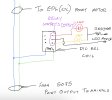timichl100
Registered
A little background; I am using (2) Piko 35260 Switch Control boxes on my layout to control 8 points. Three of the points are in the shed train yard. The other 5 are on the layout but some are difficult to see from the control box location. I have seen Switch control panels with LED indicators to show the direction the switch is in on smaller scale layouts but have not seen anything comparable for G scale. Is there a product that can be connected to the Piko switch control box that can indicate the switch direction for each individual switch, or is there a circuit design I can add to the switches to power on LEDs showing direction on a map? I'm hoping this makes sense.
Thanks
Tim
Thanks
Tim

